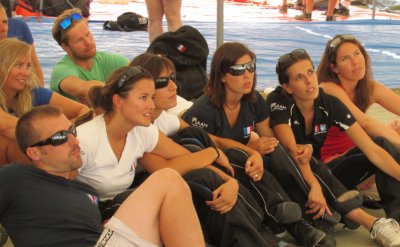
National
Skydiving
League
226 Pecan Street
Deland FL 32724
tel: (386) 801-0804
© 2003 - 2025
All Rights Reserved


226 Pecan Street
Deland FL 32724
tel: (386) 801-0804
© 2003 - 2025
All Rights Reserved


That's the time when the rules of Formation Skydiving competition get their latest tweaks if necessary. The IPC has a committee of experts in Formation Skydiving competition who collect information and feedback year by year and turn it into adjustments of the rules.
The world of rules has been quiet and peaceful for many years in the traditional Formation Skydiving competition events, as dive pool and the general outline of the rules have been working very well. Only smaller adjustments have been made in the recent years, and another one is coming out of this year's meeting.
| Rd. 10 Aerodyne French Girls | Rd. 10 Golden Knights |


The Sun Path Products reported the dramatic battle between Golden Knights and Aerodyne French Girls in 4way Women comprehensivley. The French national team won the gold medals after a jumpoff round and the following tie-breaking procedure.
The story on 14 November 2013 followed up with an article that Blue Skies Mag published under the TURNING POINTS column. "Sudden Death" evaluated the current tie-breaking rules and suggested better solutions.
Click on the score for a round with a link to see the teams' videos
| World Cup 2013 | Rd. 1 | Rd. 2 | Rd. 3 | Rd. 4 | Rd. 5 | Rd. 6 | Rd. 7 | Rd. 8 | Rd. 9 | Rd. 10 | Rd. 11 | T. | |
| Rank | 4way Women | O,4,H,3 | 9,17,P | L,1,G,12 | 7,10,21 | 16,E,A,15 | 8,2,B | 18,5,Q | F,14,K,N | M,C,D,13 | 20,J,19 | 22,J,19 | T. |
| 1 | Aerodyne French Girls | 21 | 27 | 16(-2) | 18 | 20(-1) | 17 | 17(-2) | 23 | 24(-1) | 20 | 17 | 220 |
| 2 | Golden Knights | 22 | 25 | 17(-2) | 17 | 19(-1) | 18 | 21 | 20(-3) | 24(-1) | 20 | 17 | 220 |


There will still be a jumpoff round if two or more teams are tied in a medal position after all completed rounds. The following three levels of tie-breaking rules (highest score for a single round - highest score between the teams in reverse order - fastest time in the last common round) have been simplified, and only the fastest time in the last common round counts from here on:
3.2.2.1.2 For determination of the final placings:
i. One tie break round, if possible (for the first three placings only). The tie break round will be the next drawn round of the competition.
ii. The fastest time (measured to hundredths of a second) to the last common scoring formation in the last completed round after the jumpoff.![]()

The difference to the previous tie-breaker is the goal to have the better team at the end of the competition win. The highest score of the meet could be scored in Round 1 and might be several days old, and the same counts for the highscore in reverse order. The faster completion of the last common scoring point in working time is a more realistic way to determine the winner at the end of the competition.
The new rule definition would have brought a different winner at the World Cup 2013. The Golden Knights completed the Chinese T of Block 22 a little earlier than the French Girls in the jumpoff round. But that's history, and new jumpoffs and tie-breakers will hopefully come again this year...